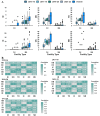Network analysis of farmed Atlantic salmon movements in British Columbia, Canada
- PMID: 40607346
- PMCID: PMC12218256
- DOI: 10.3389/fvets.2025.1568484
Network analysis of farmed Atlantic salmon movements in British Columbia, Canada
Abstract
An inherent issue to the Atlantic salmon aquaculture production is the possible transmission of infectious pathogens due to the transportation of live fish. This study employed network analysis to model the contribution of Atlantic salmon transfers to the spread of pathogens. We used a publicly available salmon transfer dataset covering the period 2015-2022. Official records showed that 812 transfers of Atlantic salmon occurred between various British Columbian (BC) salmon production units in that timeframe. For the purpose of evaluating changes in the network structure of farmed Atlantic salmon movements, the daily networks were aggregated into two-year periods to generate a time-ordered series of biennial movements. The freshwater hatchery and marine netpen sites comprised the two types of facilities that made up the Atlantic salmon transfer network, which consisted of 99 nodes (facilities) and 350 edges (links) overall. All the networks showed both scale-free and small-world topology, which would encourage the persistence and spread of pathogens in the Atlantic salmon facilities while simultaneously making it easier to develop risk-based surveillance techniques by focusing on high centrality nodes. Additionally, the rare occurrence of high betweenness and reach, presence of disassortative mixing, negative correlation between the in- and out-degree and between ingoing and outgoing infection chain of facilities, and the identification of freshwater hatcheries as potential superspreaders all suggest that Atlantic salmon transfers might not play a significant role in the spread of pathogens between facilities in the British Columbian Atlantic salmon farming industry. Community detection revealed two or three communities persistently in the aquaculture management unit (AMU) level network, and it would be more effective to make zoning based on AMU. In conclusion, targeted surveillance efforts on high-centrality facilities can be employed to combat any infectious outbreak in the BC Atlantic salmon industry caused by live Atlantic salmon movement.
Keywords: Atlantic salmon; disease control; fish diseases; network analysis; risk-based surveillance.
Copyright © 2025 Raquib, Hammell, Sanchez, O’Brien and Thakur.
Conflict of interest statement
The authors declare that the research was conducted in the absence of any commercial or financial relationships that could be construed as a potential conflict of interest. The author(s) declared that they were an editorial board member of Frontiers, at the time of submission. This had no impact on the peer review process and the final decision.
Figures







Similar articles
-
Measures implemented in the school setting to contain the COVID-19 pandemic.Cochrane Database Syst Rev. 2022 Jan 17;1(1):CD015029. doi: 10.1002/14651858.CD015029. Cochrane Database Syst Rev. 2022. Update in: Cochrane Database Syst Rev. 2024 May 2;5:CD015029. doi: 10.1002/14651858.CD015029.pub2. PMID: 35037252 Free PMC article. Updated.
-
Systemic pharmacological treatments for chronic plaque psoriasis: a network meta-analysis.Cochrane Database Syst Rev. 2021 Apr 19;4(4):CD011535. doi: 10.1002/14651858.CD011535.pub4. Cochrane Database Syst Rev. 2021. Update in: Cochrane Database Syst Rev. 2022 May 23;5:CD011535. doi: 10.1002/14651858.CD011535.pub5. PMID: 33871055 Free PMC article. Updated.
-
Systemic pharmacological treatments for chronic plaque psoriasis: a network meta-analysis.Cochrane Database Syst Rev. 2017 Dec 22;12(12):CD011535. doi: 10.1002/14651858.CD011535.pub2. Cochrane Database Syst Rev. 2017. Update in: Cochrane Database Syst Rev. 2020 Jan 9;1:CD011535. doi: 10.1002/14651858.CD011535.pub3. PMID: 29271481 Free PMC article. Updated.
-
Sertindole for schizophrenia.Cochrane Database Syst Rev. 2005 Jul 20;2005(3):CD001715. doi: 10.1002/14651858.CD001715.pub2. Cochrane Database Syst Rev. 2005. PMID: 16034864 Free PMC article.
-
Population-based biomedical sexually transmitted infection control interventions for reducing HIV infection.Cochrane Database Syst Rev. 2011 Mar 16;(3):CD001220. doi: 10.1002/14651858.CD001220.pub3. Cochrane Database Syst Rev. 2011. PMID: 21412869
References
-
- Johnson DL, Pearce CM, Flaherty MS, Cowen LL, Black MJ, Worst SV, et al. Factors affecting the spatial and temporal distribution of biofouling communities on Atlantic salmon (Salmo salar) farms: insights from the Broughton archipelago, British Columbia, Canada. Biofouling. (2025) 41:20–35. doi: 10.1080/08927014.2024.2430353, PMID: - DOI - PubMed
-
- Charlebois S, Gone KP, Saxena S, Colombo S, Sarker B. Assessing consumer implications of reduced Salmon supply and environmental impact in North America. Sustainability. (2024) 16:3629. doi: 10.3390/su16093629 - DOI
LinkOut - more resources
Full Text Sources

